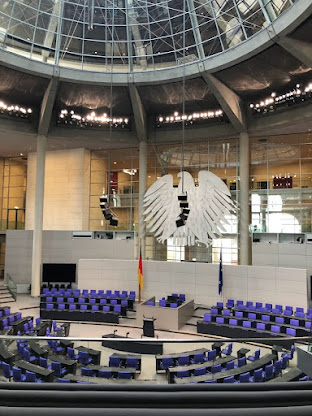Blocker Blog - Entry 7: Reichstagsgebäude
Near the end of my time in Berlin, I was able to book a tour of the Reichstagsgebaude, also known as the Bundestag, the government building where the German parliament meets. Though the tour itself was free, it was difficult to find a time slot for it because it is a heavy tourist attraction and spots were taken fast. Nevertheless, I was able to book a tour in English on a Tuesday afternoon. The building itself is smaller than the Capitol Building in the United States but still no less important for having a long history. Like the Capitol Building, the Bundestag has extensive security, all visitors had to go through a bag check; no food was allowed and only light small bags were permitted. Though it was like going through TSA at the airport the aura was rather calm, at least in comparison to the time I visited the Capitol, perhaps it was how laid back all the staff was, they were not wearing any type of visible protective armor, nor were there was not any firearms present; this made me think of how different social security might be to the US.
After entering, I was assigned a group and was told to wait for the tour guide to arrive, giving me time to look around the place. Despite how small it is the building was pretty tall in stature, the floor we were in had a high ceiling, there was a grand window that showed an open space to one of the courtyards. After a couple of minutes the guide arrived and we started the tour. We were first shown the entrance of the room where the parliament actually meets where the tour talked about the eagle that in the center of the room, he referred to it as the Turkey like many others do around here, since its design makes the eagle look like a fat bird. Then we were headed towards a set of hallways and waiting areas where there are writings all throughout the walls. All of this writing, we were told, was written by Soviet Soldiers in 1945 as the Allies were executing their final stance against Hitler, where the Soviet army actually took over the building and wrote all over the walls, presumably insults to the dictator. As to why the current government decided to leave such writings is something that I have never seen; for history to be left intentionally on a historic building. It just shows a bold way for Germany to acknowledge its past. Back in DC, I do not see the negative parts of history embedded in today’s Capitol, it all seems clean and pristine, as if nothing has ever happened in the over 200 years of history that the US has.
Another aspect that I found unique was how close were visitors allowed in certain parts of the Reichstag that political leaders also take place. An example would be one of the reading rooms where the Chancellor is often at. It would be the equivalent of being in the Oval Office, of which is a restricted area for visitors. There seems to be more of a trust system between the people and the government by allowing such clarity and openness. After that we were directed to the basement where there are rooms of historical significance. For one we were shown the work of French artist Christian Boltanski where it shows the democratically-elected officials in Germany between the years of 1919 and 1999; these officials names were shown through labeled metal boxes that made a type of hallway. The one box that was left empty was to represent the years where Germany had not elected their leader through democratic means. Again, this is something that I just do not see in the United States, I only see the pretty and pristine things about government as well as the victories and milestones that the country has gone through. This left me something to think about deeply when returning to the US when it comes to remembering how the government has represented all of its people through the years.





Comments
Post a Comment